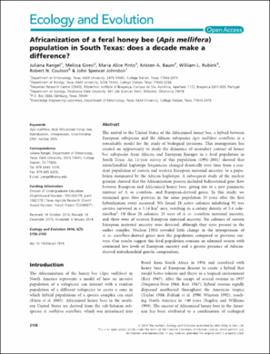| dc.contributor.author | Rangel, Juliana | |
| dc.contributor.author | Giresi, Melissa | |
| dc.contributor.author | Pinto, Maria Alice | |
| dc.contributor.author | Baum, Kristen A. | |
| dc.contributor.author | Rubink, William L. | |
| dc.contributor.author | Coulson, Robert N. | |
| dc.contributor.author | Johnston, John Spencer | |
| dc.date.accessioned | 2019-08-22T17:50:57Z | |
| dc.date.available | 2019-08-22T17:50:57Z | |
| dc.date.issued | 2016 | |
| dc.identifier | oksd_rangel_africanizationo_2016 | |
| dc.identifier.citation | Rangel, J., Giresi, M., Pinto, M. A., Baum, K. A., Rubink, W. L., Coulson, R. N., & Johnston, J. S. (2016). Africanization of a feral honey bee (Apis mellifera) population in South Texas: Does a decade make a difference? Ecology and Evolution, 6(7), 2158-2169. https://doi.org/10.1002/ece3.1974 | |
| dc.identifier.uri | https://hdl.handle.net/11244/321250 | |
| dc.description.abstract | The arrival to the United States of the Africanized honey bee, a hybrid between European subspecies and the African subspecies Apis mellifera scutellata, is a remarkable model for the study of biological invasions. This immigration has created an opportunity to study the dynamics of secondary contact of honey bee subspecies from African and European lineages in a feral population in South Texas. An 11-year survey of this population (1991-2001) showed that mitochondrial haplotype frequencies changed drastically over time from a resident population of eastern and western European maternal ancestry, to a population dominated by the African haplotype. A subsequent study of the nuclear genome showed that the Africanization process included bidirectional gene flow between European and Africanized honey bees, giving rise to a new panmictic mixture of A.m.scutellata- and European-derived genes. In this study, we examined gene flow patterns in the same population 23 years after the first hybridization event occurred. We found 28 active colonies inhabiting 92 tree cavities surveyed in a 5.14 km2 area, resulting in a colony density of 5.4 colonies/km2. Of these 28 colonies, 25 were of A.m. scutellata maternal ancestry, and three were of western European maternal ancestry. No colonies of eastern European maternal ancestry were detected, although they were present in the earlier samples. Nuclear DNA revealed little change in the introgression of A.m.scutellata-derived genes into the population compared to previous surveys. Our results suggest this feral population remains an admixed swarm with continued low levels of European ancestry and a greater presence of African-derived mitochondrial genetic composition. | |
| dc.format | application/pdf | |
| dc.language | en_US | |
| dc.publisher | Wiley Open Access | |
| dc.rights | This material has been previously published. In the Oklahoma State University Library's institutional repository this version is made available through the open access principles and the terms of agreement/consent between the author(s) and the publisher. The permission policy on the use, reproduction or distribution of the material falls under fair use for educational, scholarship, and research purposes. Contact Digital Resources and Discovery Services at lib-dls@okstate.edu or 405-744-9161 for further information. | |
| dc.title | Africanization of a feral honey bee (Apis mellifera) population in South Texas: Does a decade make a difference? | |
| osu.filename | oksd_rangel_africanizationo_2016.pdf | |
| dc.description.peerreview | Peer reviewed | |
| dc.identifier.doi | 10.1002/ece3.1974 | |
| dc.description.department | Zoology | |
| dc.type.genre | Article | |
| dc.type.material | Text | |
| dc.subject.keywords | apis mellifera | |
| dc.subject.keywords | feral africanized honey bee | |
| dc.subject.keywords | hybridization | |
| dc.subject.keywords | introgression | |
| dc.subject.keywords | mitochondrial dna | |
| dc.subject.keywords | nuclear dna | |
